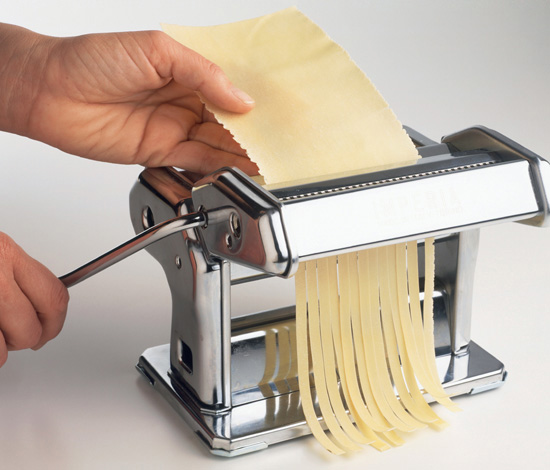
Noodles and rice have been staples on numerous international menus for centuries. Nourishing and extremely versatile, they come in many forms and can be combined with just about anything.
Nothing beats the taste of fresh, homemade pasta. While it requires some effort, it is not difficult and making food from scratch can be therapeutic.
Here are some basic recipes for pasta dough.
For pasta without egg:
1 Mix about 3/4 cup (180 g) durum wheat semolina flour with about 2/3 cup (140 g) all-purpose flour and a pinch of salt. Add 3/4 cup (180 ml) water and knead into a smooth, elastic dough.
2 Add a little more water if the dough is too dry—it should be solid but not sticky.
3 Let it sit for 1 hour, roll it thinly, cut into your desired shape and let it air-dry.
• Pasta made from durum wheat is particularly good with thick sauces.
For egg noodles:
1 Knead 1 cup (260 g) all-purpose flour, 3 lightly beaten eggs, 1 teaspoon (5 ml) salt and 1 tablespoon (15 ml) olive oil into a smooth dough. (It’s ready when shiny and it loosens from the work surface.)
2 Let it rest, roll it out, cut it up and let it dry.
IT’S EASY TO roll out and cut pasta dough with a PASTA MACHINE.
• Brew coffee when you make pasta—it helps to have moist air in the kitchen.
• Turn dough over several times to make the process of rolling it out easier.
• Work on pasta dough in sections. Put the rest in aluminium foil to keep it from drying out.
• Egg noodles can be colored and flavored: beet juice turns them dark red; tomato purée, light red; carrot or pumpkin purée, orange; saffron, yellow; spinach, green; mushrooms, brown; and squid ink, black. Mix these ingredients with the eggs, oil and salt, then knead with the flour. You may need more flour to compensate for extra moisture.
• To make tortellini, roll out the dough and cut small squares before adding a dab of filling in the middle. Moisten the edges in so that they stay together and carefully fold the dough over the filling.
• Use a large, deep saucepan for cooking so that the noodles can move freely while they boil.
• Pasta swells to about two-and-a-half times its original volume during cooking. Make sure you add it to water at a full rolling boil.
• Stir pasta around as soon as it is in the water so that it keeps its shape and doesn’t stick together.
• Don’t add oil to the water. Although it prevents water from boiling over, it won’t stop the pasta from sticking together and can prevent the noodles from holding the sauce well.
• Add a little stock to the water for a zestier flavor.
One of the oldest cultivated plants, rice has shaped the culture, diet and economy of Asia. Without a doubt, it’s the world’s most important food staple.
• Long-grain and basmati rice both have long, slender grains and a dry, glassy core. For best results, wash them thoroughly before cooking. Then, bring one part rice and two parts salted liquid to a boil, lower the heat and cook, covered, for 15–20 minutes.
Note: There is no need to soak rice before cooking, but if you do, it will reduce the cooking time; soaked rice should be rinsed to remove additional starch before cooking or the grains will not separate well.
• Before easy-cook or parboiled rice is husked and polished, hot steam is used to force about 80 percent of the vitamins and minerals contained in the outer membrane into the rice grain so that it’s high in nutrients. To cook it, bring one part rice and two parts salted liquid to a boil, then lower the heat. Cook, covered, for 20 minutes.
• Short-grain rice is chalk white and soft and sticky at the core. It produces plenty of starch when cooked and can be used for risottos and sweet dishes. Use one part rice to one part water. Bring water to a boil, then reduce heat and cook, covered, for 10 minutes or until done.
• Brown rice is nutrient-dense and high in fiber. Soak it overnight or for 4 hours. Bring one part rice and two parts salted liquid to a boil, then lower the heat. Cook, covered, for 20–25 minutes.
• Unless you’re making risotto, don’t stir rice while you’re cooking it—the result will be a starchy mess.
• Most rice varieties triple in size when cooked. A side dish of cooked rice is about 1/2 cup (125 g).
• Rice is even tastier when prepared in stock or water and wine, as when making a risotto.
• Reuse cooked rice as fried or baked rice with the help of oil and spices, and additions such as eggs, leftover meat and vegetables. It’s also good in soups.
• Add a pat of butter to the water to keep rice from boiling over.
• If rice is too moist after cooking, let it dry for 10 minutes in a baking pan in the oven.
• If the rice is sticky, drain it in a colander and pour a kettle of boiling water over it to separate the grains.
• Store rice in a dry, well-ventilated place away from strong-smelling foods; it absorbs other flavors easily.

The water-to-rice ratio and cooking times vary for each type and brand of rice; always follow the package directions.
GOOD TO KNOW 
Nutrient-rich rice bran
The nutrients in a rice kernel are mainly in the bran. For maximum nutritional value, choose natural or whole-grain rice that has not had the bran removed or parboiled rice.